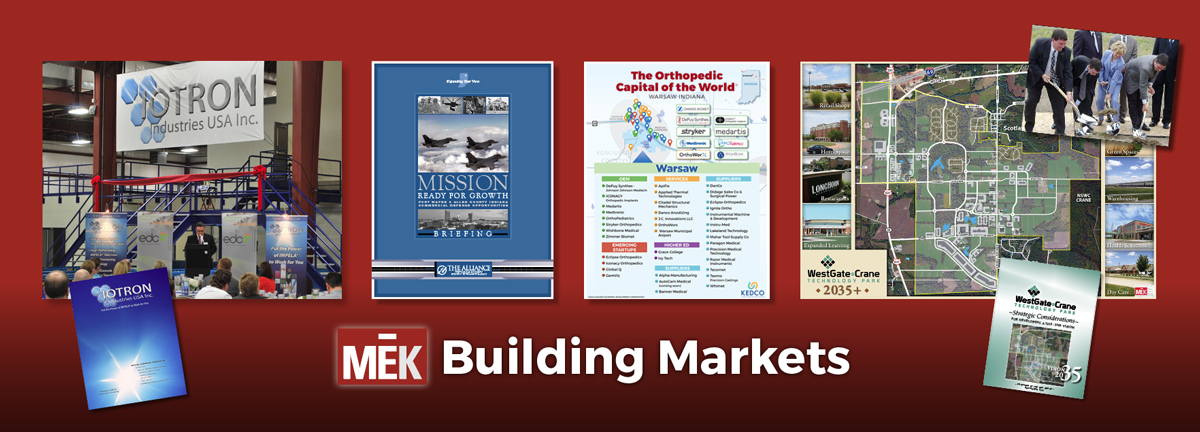Building Markets

Isolated bean fields to creating a vibrant $100 million tech park. From Vancouver, Canada to building markets for a high-tech medical device sterilization facility in NE Indiana. A quality of place framework for funding growth initiatives. A medical and education campus option for a growing region. A Congressional tour to elevate Indiana defense tech. Legislative tools to map medical device growth potential.
A strategic catalyst – MEK initiates, engages, and collaborates with business leaders, economic developers, state and federal agencies and more to successfully identify, evaluate, map out and plan, and execute/expand market entry for a wide variety of clients.
A Viral White Paper
For MEK, who often has been termed a “trusted partner” in these ventures, it began with an out-of-the-park white paper. Stark reality in 2003: the $2 billion Naval Surface Warfare Center south of Bloomington, a major employer, could downsize or outright close. A reprised 2005 Base Realignment and Closure process (BRAC) loomed. Such a BRAC event would economically devastate south central Indiana.
- A MEK-produced white paper detailing key BRAC issues and possible solutions went viral
- Statewide editorials, speeches, national defense summaries and presentations re-published or quoted key sections
- Described by one defense economic specialist as “effective public affairs artillery on key strategic coordinates”
The white paper helped lay a foundation for action. As it would do later for other clients in different fields, MEK played a subsequent integral role in identifying and helping secure needed initial capital and agency buy-in for what today is known as the $100 million WestGate@Crane Technology Park (read summary here).

Strategic Framework
Over time, creating an environment for growth involved many people, officials, and influencers. A MEK framework for entering markets, which is adapted for several industries, emerged. Here are selected elements to consider:
Evaluate the proposed market and market resources
- Is there truly a local or regional need within the market?
- Is sufficient capital available to enter? (what are available sources, including unusual, non-routine sources?)
- Is sufficient talent available? (can be local or remote)
- What talent and workforce building tools are accessible? (university involvement, existing non-competitive businesses and enterprises, regional associations)
- What is the level of commitment from local, regional, state and national key influencers and stakeholders?
- Who are key leaders and influencers who can provide leadership and believability to promote buy-in?
- What decision data is available? What is needed (Gatekeeper research, industry database survey outreach, perspectives of leaders and media)
- Identify supply chain (including intellectual talent) issues

Identify existing and future support mechanisms
- Identify natural market buyers and supporters
- How will your idea, product, service, or resource enhance existing companies, regions, markets?
- Who (or what) opposes the idea or initiative? What “initiative of the day” fatigue issues or experiences exist?
- Sample what key influencers (e.g. site selectors or market advisors) think or perceive of your proposed initiative or market enhancement

Build consensus and buy-in
- Match the initiative or product/service to key influencers (can be a major challenge)
- Identify, anticipate and manage the dynamics of your process
- Create appropriate communication tools (video, briefing documents, animation, white papers, sales and fact sheets, initiative summaries, infographics)
- Creatively identify media opportunities to tell your story; present leadership to create aura of opportunity and achievement; build your brand and reputation
- Identify opposition and research underlying elements; how can win-win situations be created?
- Remember that every person, organization and initiative has a “brand,” whether it wants one or not
- Actively practice reputation management and brand development (a brand is a living collection of mental, emotional, cognitive and personal preferences and perspectives)

Advance your initiative and shape your market entry
- Provide context for assembling a strategic team (your perspective is often critical for success)
- Identify needed team members and proactively offer direction
- Identify where other agencies, organizations, businesses, associations and even sales teams can play a positive role; ask for their advice and input
- If your organization deploys a lobbyist, ensure that they have access to your information/role and share resources as appropriate
- Often a delicate balance is required (the most effective PR is invisible)
- If you’re responding to a government or agency RFP, make certain you provide all information requested/required and play by the rules
- Create a strategic event or reward process to celebrate your wins and market entry; create opportunities for your supporters to tell your story on your behalf – achieving a third-party, highly believable endorsement
- Create, monitor and manage digital communication opportunities to support your initiative or market making
- Be agile!

Every process is different, with different dynamics.
If you would like to discuss, call or email us!
